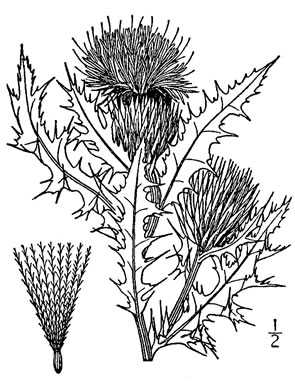Spermatophytes (seed plants): Angiosperms (flowering plants): Eudicots: Core Eudicots: Asterids: Campanulids: Asterales
WEAKLEY'S FLORA OF THE SOUTHEASTERN US (4/24/22):
Cirsium pumilum
FAMILY
Asteraceae__
Go to FSUS key
Dig deeper at SERNEC, a consortium of southeastern herbaria.
Read more about Pasture Thistle at Vascular Plants of North Carolina.
SYNONYMOUS WITH
PLANTS NATIONAL DATABASE:
Cirsium pumilum
FAMILY
Asteraceae__
SYNONYMOUS WITH Flora of North America north of Mexico, vol. 19-20-21 (2006)
Cirsium pumilum var. pumilum
SYNONYMOUS WITH VASCULAR FLORA OF THE CAROLINAS (Radford, Ahles, & Bell, 1968) 179-25-012:
Carduus pumilus FAMILY Asteraceae__
SYNONYMOUS WITH Manual of the Southeastern Flora (Small, 1933, 1938)
Cirsium odoratum
COMMON NAME:
Pasture Thistle
To see larger pictures, click or hover over the thumbnails.
WEAKLEY'S FLORA OF THE SOUTHEASTERN US (4/24/22):
Cirsium pumilum
FAMILY
Asteraceae__
SYNONYMOUS WITH
PLANTS NATIONAL DATABASE:
Cirsium pumilum
FAMILY
Asteraceae__
SYNONYMOUS WITH
Flora of North America north of Mexico, vol. 19-20-21
Cirsium pumilum var. pumilum
SYNONYMOUS WITH
VASCULAR FLORA OF THE CAROLINAS (Radford, Ahles, & Bell, 1968) 179-25-012:
Carduus pumilus
FAMILY
Asteraceae__
SYNONYMOUS WITH
Manual of the Southeastern Flora (Small, 1933, 1938)
Cirsium odoratum
If a search such as "Carex leptalea var. leptalea" doesn't deliver the results you want, try "Carex leptalea".
Or, to minimize chances of a misspelling, try just "Carex le".
Less is more: If "pencil flower" doesn't deliver the results you want, try "pencil".


